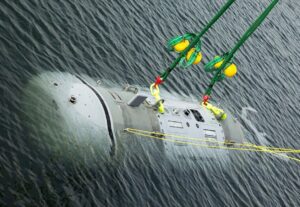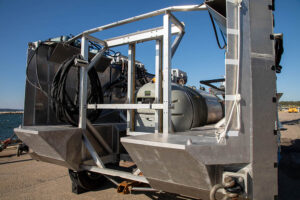The final fiscal year 2023 omnibus appropriations bill allowed the Navy to end the Snakehead Large Displacement Unmanned Undersea Vehicle (LDUUV) program, but urged prioritization in using commercial alternatives.
The Navy’s FY ‘23 budget request documents said the service planned to eliminate
the Snakehead program due to cost and schedule delays on vessel development and integration with Virginia-class attack submarines (Defense Daily, April 18).

A budget highlights book argued a “misalignment of Snakehead LDUUV design and procurement efforts with submarine hosting interfaces resulted in limited availability of host platforms to conduct Snakehead operations.”
Without a more fully developed submarine integration, the Snakehead was limited to an alternative launch and recovery interface via Modernized Dry Deck Shelters.
Ending the program entails canceling the FY ‘22 Phase 2 contract award, which the Navy said would save about $186 million in FY ‘23 and ultimately about $517 million total over the next five years.
Snakehead has been an accelerated acquisition program that sought to field a long-endurance multi-mission LDUUV deployable from ports, attack submarines and Littoral Combat Ships as the largest submarine-launched UUV.
The vessel was planned to support intelligence, surveillance and reconnaissance (ISR) and anti-submarine undersea missions.
In July, the Senate Armed Services Committee’s FY ‘23 defense policy bill recommended saving the Snakehead by adding $100 million in research and development funding (Defense Daily, July 20).
“Despite program schedule underperformance, the committee believes the Snakehead Large Displacement Unmanned Undersea Vehicle could provide an important capability to the fleet once fielded,” the committee said.
However, appropriators did not take them up on the recommendation, only noting advances in the commercial sector and encouraged the Navy prioritize the advancements in the commercial sector.
An explanatory statement released with the defense portion of the omnibus appropriations package acknowledged the Biden administration’s divestment plans but underscored “there have been significant advancements in commercially available unmanned undersea vehicle (UUV) technology since the inception of the Snakehead LDUUV program.”
The statement encouraged the Secretary of the Navy to “prioritize advancements in autonomy, endurance, and multi-mission payload capability now available in the commercial LDUUV sector.”
“The Secretary of the Navy, in consultation with the Chief of Naval Operations and the Assistant Secretary of the Navy (Research, Development. and Acquisition), is encouraged to integrate available commercial LDUUV platforms into the test and evaluation schedule for UUVs,” the statement continued.
The appropriators also encouraged the Navy Secretary to integrate commercially available UUV technology into the Navy and Marine Corps’ concept of operations development and resourcing, procurement and fielding plans over the next five years.
The Navy previously planned for three Snakehead vehicles to finish modernization between FY 2022 and 2026 and become available for fleet use in FY ‘22, ‘23 and ‘26.

The Navy christened the first Snakehead prototype in Rhode Island February 2022 (Defense Daily, Feb. 15).
A 2021 request for proposals said the Navy planned to award a competitive contract to build two Snakehead prototypes, with one Phase 1 vehicle fabricated in FY ‘21 and was set to undergo in-water testing in FY ‘22.
Phase 2 would be another competitive award originally expected in the first quarter of FY ‘22 and include increased capabilities and possible integration onto surface ships. Depending on how the early work went, the Navy had considered transitioning Snakehead to an acquisition category program as soon as FY ‘25.
A late as August, the Navy announced progress in the Snakehead prototype vehicle and how it demonstrated sortie endurance testing and had conducted a total of 155 in-water sorties and over 78 hours of runtime (Defense Daily, Aug. 12).
More recently, in October, a Navy team used the Snakehead to help demonstrate a new solution to launch large UUVs from Navy amphibious ships, also utilizing an HII [HII] Pharos large launch and recovery vehicle (Defense Daily, Dec. 20).